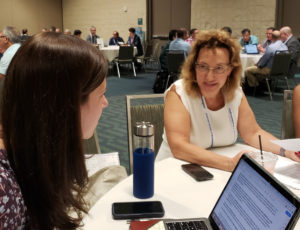Research is a critical component for furthering medical treatment, but it can seem almost impossible to undertake without the support of a grant. With the right resources and type of study, however, launching a research project is not only possible, it may be the best way to secure grant money for your next project.

Galina Leyvi, M.D.
“Conducting a retrospective study is a good place to start to establish your reputation as a researcher and prove yourself to your chair,” said Galina Leyvi, M.D., of Montefiore Medical Center in Bronx, New York, who led the roundtable discussion during Sunday morning’s session “How to Start and Conduct a Research Project in an Academic Anesthesia Program Without a Grant.”
She explained that a retrospective study is often less expensive and requires less training for human resources. These are the two key components for successfully undertaking a research project in the absence of grant money. While a non-randomized or retrospective research study may not the be the “gold standard” of the randomized controlled study, they are still important because they can be integral in formulating research questions for future randomized studies.
While randomized studies require trained personnel, such as experienced research assistants and research nurses, a retrospective study can employ the assistance of medical students, residents and fellows, Dr. Leyvi said.
Residents are often motivated to participate in research because they are strongly encouraged by their sponsoring institution to involve themselves in scholarly activity during their training period, she added.
“Medical students are also encouraged to be involved in clinical research, which will strengthen their applications for a residency program,” Dr. Leyvi said. “A retrospective study can be conducted with significant help from medical students, residents and fellows and, at the same time, give a great opportunity for training residents to generate research questions, choose methods, collect and analyze data, perform statistical inference, write the abstract and submit a manuscript.”
Just be aware that there are limitations for using a team of medical students, residents and fellows to help with your research project.
“When you use lots of medical students, it’s important to know what you can and cannot let them do,” Dr. Leyvi said. “For example, they should not do consent. That should be done by you or the research assistant or someone who has the background to make sure there is no violation of patient rights.”
A medical student helping with research also should not do a blood draw or have any physical interaction with the patient involved in the study, she added.
Finding this free labor should not be difficult, Dr. Leyvi said, “Anesthesiology is very popular as a residency program right now.”
Return to Archive Index